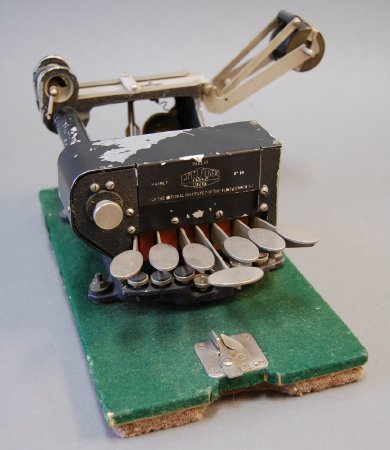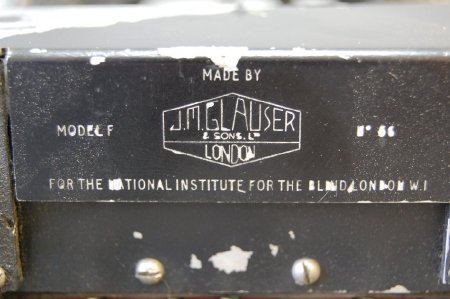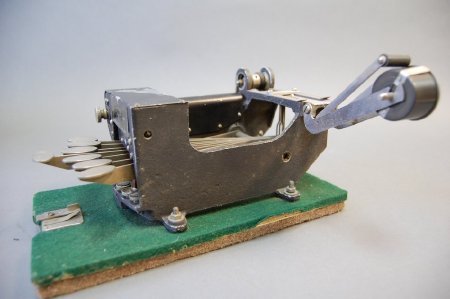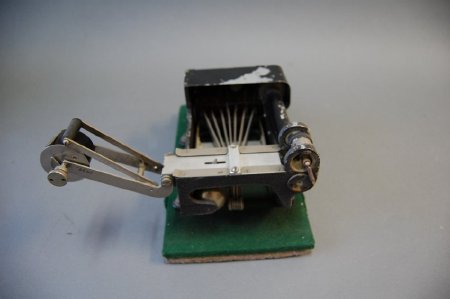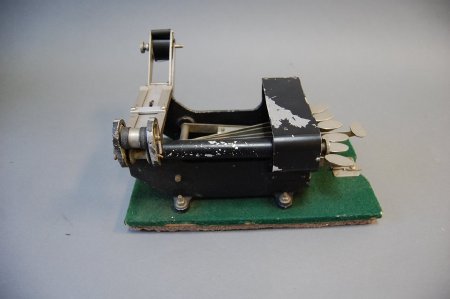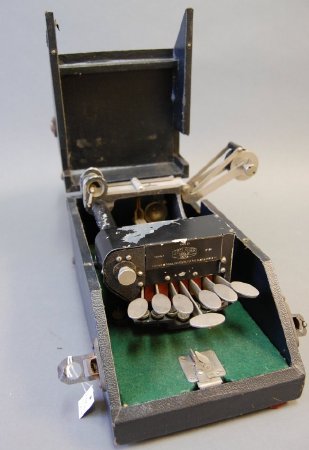Object ID:
1999.29.1-2
Title:
Model F Braille Shorthand Writer
Description:
Cast aluminum frame, enameled black; stamped aluminum housing, also enameled black, wrapped around top of keyboard on front and around paper tape advance roller on left; folding nickel plated paper reel arm on back right holds a removable black plastic reel with a nickel-plated brass thumbscrew/axle; a secondary tape roller extends from the base of the reel arm and rests on top of the primary reel; six nickel-plated brass, oval keys and a spacing key in the middle with its pad set perpendicular to the other keys; key arms are numbered: 3,1,2,4,2,1,3 on their left side; padded rests under each key; nickel-plated brass paper tape advance knob above and to left of keyboard, extending back to a pair of spring loaded rollers on the back left of the frame; paper tape reel end bell on screwed to extension on lower back right of frame; stamped onto a bar in middle of the paper tape guide on back, "F56"; stamped into housing above keyboard, "Made by J.M. Glauser & Sons. Ltd, Model F, No 56 For The National Institute For The Blind London W.I."; braillewriter is bolted to removable felt-covered wood bottom of case with four bolts; gray wool pad glued to bottom of this base.
Wooden case has hinged lid; black leatherette covering; metal hinges and locks on sides; leather handle on right side. Removable bottom serves as the base for attached braillewriter. Rubber pads (1 inch in diameter) have been attached with screws to the bottom corners of the case.
Wooden case has hinged lid; black leatherette covering; metal hinges and locks on sides; leather handle on right side. Removable bottom serves as the base for attached braillewriter. Rubber pads (1 inch in diameter) have been attached with screws to the bottom corners of the case.
Dimensions:
H-4.5 W-5.5 D-10.5 inches
Date:
ca. 1950
Made by:
J.M. Glauser & Sons, Ltd., National Institute for the Blind.
Place of Origin:
London, England
Provenance:
Henry Stainsby (1859-1925), Supt. of the Birmingham Royal Institution for the Blind, along with Birmingham manufacturer Albert Wayne patented a braille shorthand machine in 1899-1900. His tapewriter was developed as a note-taking tool for blind stenographers being trained at Birmingham. Stainsby's goal was employment for his students. By the 1920s, the Stainsby-Wayne Braille Shorthand Writer was being sold by the National Institute for the Blind. This version was introduced in 1947-48, touted in the NIB annual report as "more compact, really portable, and nearly silent in action." It was itself replaced in the mid-1950s by the Model G. J.M. Glauser & Sons was a London instrument maker who manufactured several different braillewriters for the National Institute for the Blind.
Credit Line:
Museum Purchase, 1999.29
